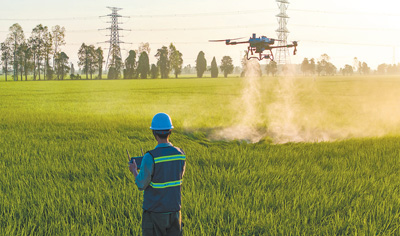Low-altitude economy takes off in China
The application scenarios of China's low-altitude economy, composed of the traditional general aviation sector and the unmanned aerial vehicle (UAV) industry, is more diverse in various industries at an accelerated pace.
The low-altitude economy, which is regarded as a strategic emerging industry, is known by its high scientific and technological content.
The low-altitude economy is finding more and more application scenarios, including agricultural and forestry protection, meteorological detection, medical assistance, personal consumption, aerial sightseeing, and logistics, according to an official with the Civil Aviation Administration of China (CAAC).

An operator flies a T60 agricultural drone, developed by Chinese drone maker DJI, in Jiangmen city, south China's Guangdong Province. (Photo/Liu Xiaozhong)
Data shows that the annual average growth rate of the flight hours of traditional general aviation in China has exceeded 12 percent in the past three years. By the end of 2023, China had registered around 1.27 million UAVs, or drones.
Estimates showed that the scale of China's low-altitude economy surpassed 500 billion yuan ($69.35 billion) in 2023, and is expected to reach 2 trillion yuan in 2030.
China's innovation capabilities and solid industrial foundations are credited for the thriving low-altitude economy.
"In recent years, China's research and development (R&D) investment and innovation capabilities for UAVs and general aviation equipment have grown rapidly, and the country can develop various types of equipment," said Zhang Zhaohua, an assistant chief engineer at the Aviation Industry Development Research Center of China.
Zhang added that China has become a first-tier player in the world in terms of the development level of electric vertical takeoff and landing (eVTOL) aircraft.
Qin Rui, director of the low-altitude economy and low-altitude traffic research center at Civil Aviation University of China, said China has shifted from following others to keeping pace in drone technology through independent innovation in less than 20 years.
China accounts for about 70 percent of the global market share for consumer drones and leads in technologies for light, small, and medium-sized drones in the world.
Shenzhen city in south China's Guangdong Province is home to over 1,700 drone enterprises, with annual output value reaching 96 billion yuan. It has become a highland for the drone industry with a concentration of professional talent, a complete industrial chain and rich application scenarios, according to an executive of Chinese drone maker DJI.
This reflects the strength of China's drone industry chain and supply chain, Qin said.
From R&D design and system integration to lean production and airworthiness, China has ensured support capacity for the entire drone industry chain, and has built hubs related to the low-altitude economy like the Guangdong-Hong Kong-Macao Greater Bay Area, the Yangtze River Delta region, and Chengdu-Chongqing region, Qin explained.
The vigorous development of the low-altitude economy is inseparable from long-term policy support.
The CAAC has established a system of general aviation standards and laws, has approved trials for general aviation reform in various fields covering over 80 percent of provincial-level regions in China, and has released over 10 normative documents for the drone sector, which has created a science-based and efficient institutional environment.
By the end of 2023, China had 690 registered general aviation enterprises, 2.5 times more than in 2015, and 19,000 enterprises engaged in drone operations.
Various regions and departments need to create more favorable conditions for the high-quality development of the low-altitude economy through innovation.
According to an official with China's Ministry of Industry and Information Technology, the ministry will enhance collaboration among enterprises, universities and research institutions, accelerate research into core technologies, and cultivate high-tech enterprises and specialized and sophisticated small- and medium-sized enterprises in the low-altitude economy.
The CAAC will promote the construction of general aviation airports and temporary takeoff and landing points, and will accelerate the building of a low-altitude flight service system.
The CAAC will also enhance research and planning in areas such as the airworthiness certification for aircraft, low-altitude flight service support, infrastructure construction standards, market access management, and safety supervision to boost the development of the low-altitude economy.
Photos
Related Stories
- China's technology companies provide aerial vehicle products, solutions for many industries
- Shenyang provides solid foundation for development of low-altitude economy
- Hainan's low-altitude economy soaring high
- Low-altitude economy soars as new growth engine in Wuhu, E China’s Anhui
- China's low-altitude economy soars to new heights
- China's low-altitude economy sees robust growth: report
Copyright © 2024 People's Daily Online. All Rights Reserved.









